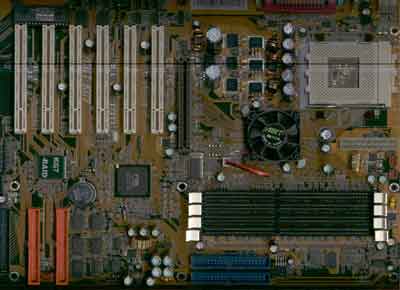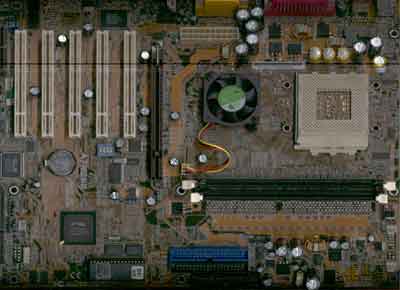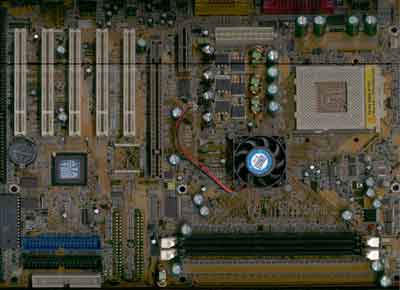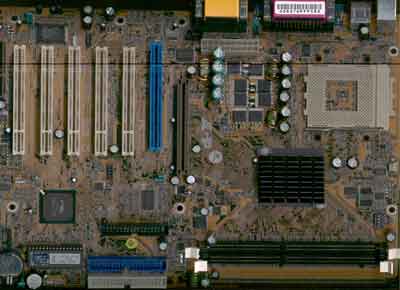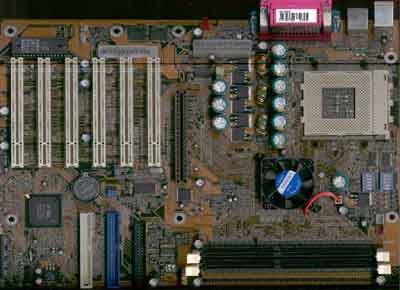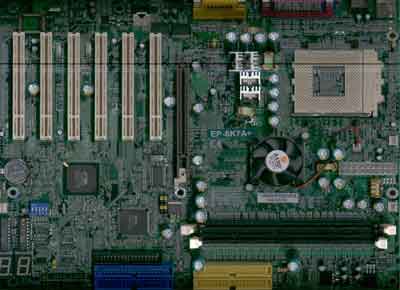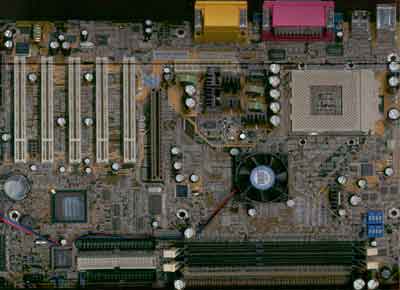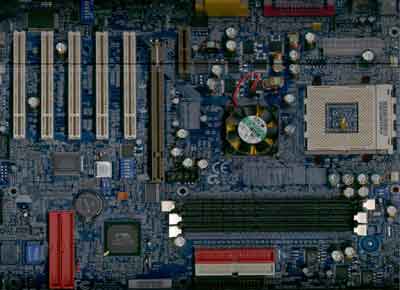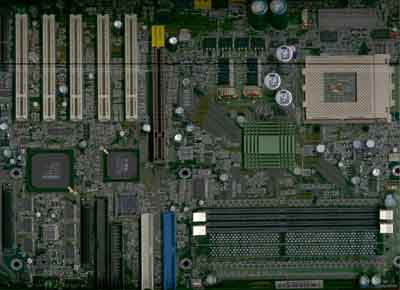
Original Link: https://www.anandtech.com/show/845
Socket-A AMD 760 Motherboard Roundup: Farewell to a Beauty
by Mike Andrawes on November 3, 2001 4:10 AM EST- Posted in
- Motherboards
Introduction
AMD's 760 chipset was the first to bring DDR SDRAM to the PC's main memory subsystem. VIA and ALi quickly followed with their own Athlon DDR chipsets, but neither of those platforms were able to keep up with the AMD 760. AMD had originally intended to introduce DDR SDRAM for the Athlon, then slowly let the 3rd parties take back the Athlon chipset market. With VIA and ALi falling behind on the performance curve, AMD had to continue supplying a large number of chipsets to the market.
More recently, we've seen the introduction of the SiS 735, then the VIA KT266A, both of which were finally able to eclipse the AMD 760. One slight problem - it's still relatively hard to find KT266A boards in the retail market and there's only one major manufacturer mass producing SiS 735 boards at this point in time. The other major contender, the NVIDIA nForce, is even further off into the future as far as retail availability goes. So if you need a DDR Athlon motherboard immediately, the AMD 760 is still a reasonable choice. Not to mention that you'll be avoiding some of the issues that have been reported with KT266 motherboards and you'll have more selection than you would with the SiS 735.
In this roundup we have a total of nine boards, they are the ABIT KG7-RAID, ASUS A7M266, Biostar, Chaintech, DFI, EPoX, FIC AD11, Gigabyte 7DXR, and the MSI K7 Master-S.
The AMD 760 Chipset and Drivers
The AMD 760 chipset debuted almost a year ago, with the main purpose being the introduction of DDR SDRAM technology. When first released, the AMD 760 chipset consisted of the 761 North Bridge and the 766 South Bridge. The AMD 761 North Bridge provides the DDR SDRAM interface and 133MHz FSB support in addition to AGP 4X support. The 766 South Bridge contains support for Ultra ATA-100 and some other features.
However, since the North and South Bridges are linked via the PCI bus, the VIA 686B and its lower price tag became the most commonly used South Bridge with the 760 chipset. In fact, all motherboards except one in this roundup use the VIA 686B instead of the AMD 766 South Bridge. The sole exception is the Chaintech CT-7KJD, which uses the VIA VT8231.
In order to make sure that this hybrid chipset performs well, install the AGP driver from AMD and the IDE drivers from VIA. For further details on the AMD 760 chipset and the technology behind it, please refer to our AMD 760 chipset review.
ABIT KG7-RAID
|
ABIT KG7-RAID |
|
|
CPU
Interface
|
Socket-462
|
|
Chipset
|
AMD
761 North Bridge
VIA 686B South Bridge |
|
Form
Factor
|
ATX
|
|
Bus
Speeds
|
100 - 200MHz (in 1MHz increments) |
|
Core
Voltages Supported
|
1.100 - 1.850 V (in 0.025V increments) |
|
I/O
Voltages Supported
|
3.5
/ 3.6 V
|
|
DIMM
Voltages Supported
|
2.44
/ 2.52 / 2.55 / 2.58 / 2.62 / 2.65 / 2.67 / 2.70 / 2.75 / 2.79 / 2.80
/ 2.83 / 2.88 / 2.92 / 2.94 / 3.00 V
|
|
Memory
Slots
|
4
184-pin DDR DIMM Slots
|
|
Expansion
Slots
|
1
AGP Slot |
|
On-board
Audio
|
N/A
|
|
BIOS
|
Award
Modular BIOS 6.00PG
|
Over the years, ABIT has become known for the overclocking capabilities of their motherboards. Although DDR chipsets have been available for almost a year, it wasn't until this year's Computex that ABT introduced their first two Socket-A DDR motherboards, one using the AMD 760 and one using the VIA KT266. In fact, it was only a few weeks ago that we finally got our hands on ABIT's AMD 760 solution, the KG7-RAID. Although it is already relatively late in the game, this board is still one of the most highly anticipated ones here. After playing with the board, we found out that the KG7-RAID is no doubt another outstanding product from ABIT. According to ABIT, one of the reasons for their late appearance in the 760 market was their decision to make a board capable of running stably with more than two DIMMs. In fact, ABIT went a step further with a total of four DDR DIMM slots on the KG7-RAID, supporting up to 4GB of memory. Most other AMD 760 boards only have 2 DIMM slots.
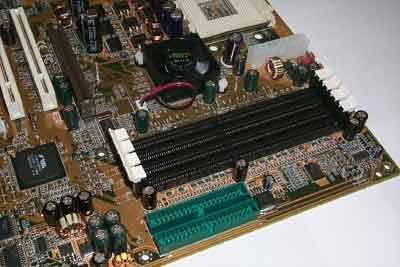
The KG7-RAID comes with 4 DDR DIMM slots, ensuring that it stands out in this
group.
Now it's one thing to include 4 DIMM slots on a motherboard, but it's an entirely different thing to ensure that they all work properly, without sacrificing stability or performance. We had no problem populating all four slots at the same time on the KG7-RAID. This is quite remarkable, considering the tight timing required for DDR SDRAM.
As we've come to expect from ABIT, the KG7-RAID offers tremendous overclocking potential. SoftMenu III provides 1MHz increments for the FSB as well as three sets of voltage tweaks. You can adjust the CPU core voltages from 1.100V to 1.850V in 0.025V increments, while the I/O voltage is adjustable from 3.5V to 3.65V. The most unique thing ABIT has done is provide adjustments for the DDR SDRAM voltage, including a total of 16 settings, with the highest being 3.0V. The jury is still out whether tweaking the memory voltage can really help when it comes to overclocking, but we'll continue to investigate.
In the front left hand corner, you'll find the Highpoint HPT370A Ultra ATA 100 RAID controller, offering two additional IDE channels. The RAID controller is capable of running in RAID 0, RAID 1, and RAID 0+1 modes. There are a total of six PCI slots.
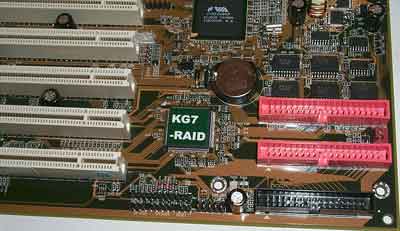
The on-board Highpoint IDE RAID controller.
Although it has arrived on the scene a little late, there is no doubt that the KG7-RAID is the best 760 motherboard available. This actually contradicts the past where ABIT has usually been among the first to use a new chipset. Nevertheless, the belated KG7-RAID does offer everything an overclocker could ask for. If this isn't appealing enough, the $140 price tag Is relatively low among this group.
ASUS A7M266
|
ASUS A7M266 |
|
|
CPU
Interface
|
Socket-462
|
|
Chipset
|
AMD
761 North Bridge
VIA 686B South Bridge |
|
Form
Factor
|
ATX
|
|
Bus
Speeds
|
90 / 95 / 100 - 180MHz (in 1MHz increments) |
|
Core
Voltages Supported
|
1.075 - 1.850 V (in 0.025V increments) |
|
I/O
Voltages Supported
|
N/A
|
|
DIMM
Voltages Supported
|
N/A
|
|
Memory
Slots
|
2
184-pin DDR DIMM Slots
|
|
Expansion
Slots
|
1
AGP Pro Slot |
|
On-board
Audio
|
C-Media
CMI 8738 Hardware Sound
|
|
BIOS
|
Award
Medallion BIOS 6.00
|
ASUS was among the first to have a 760 motherboard ready for the market. The A7M266 was available for quite awhile before ASUS stopped production in favor of the A7A266 (Ali MAGiK 1) and because AMD was cutting the supply of the 760 chipset. This halt in production was only transient as ASUS quickly realized that the ALi MAGiK1 was not going to be a popular option.
In general we usually find that ASUS motherboards are among the best, delivering high quality construction and a myriad of overclocking features. Unfortunately, with the A7M266, ASUS has not been able to live up to their own high standards.
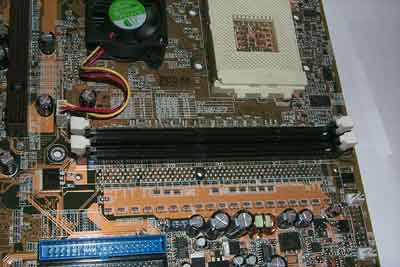
There is silkscreen for a third DIMM slot, although ASUS never made it available.
The board does offer quite a few overclocking features, such as 1MHz increments for the FSB and various voltage tweaks. The board is also very stable and of the usual high quality we've come to expect from ASUS. However, they failed to implement one key overclocking feature - CPU clock multiplier controls - greatly limiting the overclocking capabilities of the board. ASUS had in fact designed the A7M266 to support multiplier adjustments via DIP switches, but the feature was removed from all retail boards. The lack of an onboard IDE RAID controller seems minor in comparison to the lack of multiplier controls.
Making matters even worse, the A7M266 has some issues with memory compatibility as well. Our Smart Technology PC2100 DDR SDRAM would not run on the board stably at all, despite the fact that it worked on all the other boards in this roundup.
Biostar M7MIA
|
Biostar M7MIA |
|
|
CPU
Interface
|
Socket-462
|
|
Chipset
|
AMD
761 North Bridge
VIA 686B South Bridge |
|
Form
Factor
|
ATX
|
|
Bus
Speeds
|
100 / 103 / 105 / 110 / 113 / 117 / 133 / 138 / 140 / 144 / 150 MHz |
|
Core
Voltages Supported
|
Auto Detect |
|
I/O
Voltages Supported
|
N/A
|
|
DIMM
Voltages Supported
|
N/A
|
|
Memory
Slots
|
2
184-pin DDR DIMM Slots
|
|
Expansion
Slots
|
1
AGP Slot |
|
On-board
Audio
|
Sigmatel
STAC9721T AC'97 CODEC
|
|
BIOS
|
Award
Modular BIOS 6.00PG
|
One this is for sure, the Biostar M7MIA is not the board for overclockers, although it does perform decently with good stability.
The M7MIA does have a few FSB settings in the BIOS, although a jumper on the board controls the 100 / 133MHz FSB range. Other than that, the board does not have any sort of voltage or multiplier settings. Interestingly enough, the board does not have any temperature readings in the BIOS.
The most unique feature of the board is the presence of an ISA slot, the only board here with such a feature, useful only if you still have an ISA peripheral laying around that you really need.
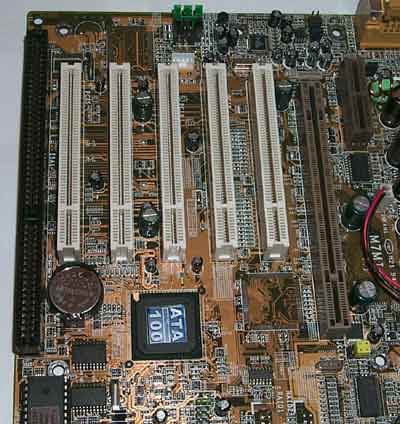
The M7MIA still retains an ISA slot.
The performance of the board is decent, making the board a nice option for those not into overclocking.
Chaintech CT-7KJD
|
Chaintech CT-7KJD |
|
|
CPU
Interface
|
Socket-462
|
|
Chipset
|
AMD
761 North Bridge
VIA VT8231 South Bridge |
|
Form
Factor
|
ATX
|
|
Bus
Speeds
|
100 - 165 MHz (in 1MHz increments) |
|
Core
Voltages Supported
|
-0.100V - +0.275 V (in 0.025V increments) |
|
I/O
Voltages Supported
|
N/A
|
|
DIMM
Voltages Supported
|
N/A
|
|
Memory
Slots
|
2
184-pin DDR DIMM Slots
|
|
Expansion
Slots
|
1
AGP Slot |
|
On-board
Audio
|
C-Media CMI 8738 Hardware Sound
|
|
BIOS
|
Award
Modular BIOS 6.00PG
|
The Chaintech CT-7KJD is the only 760 motherboard in this roundup to not use the VIA 686B. From what we can gather, the VT8231 South Bridge is actually identical to the 686B and is traditionally called the 8231 only when used in a ProSavage chipset. Perhaps Chaintech was trying to get away from the stigma associated with the 686B and some of the associated compatibility issues.
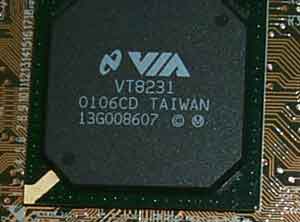
Chaintech uses the VT8231 South Bridge on the CT-7KJD.
Rather than mount a fan on the AMD 761 North Bridge, the CT-7KJD goes with an oversized heatsink for cooling, which held up just fine in our stress tests.
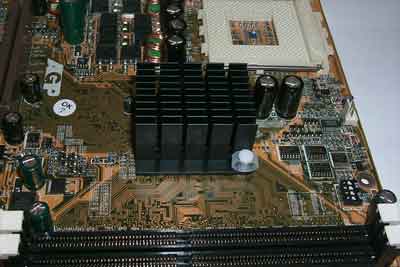
Instead of a full HSF unit, Chaintech went with a large heatsink for cooling
the 761 North Bridge.
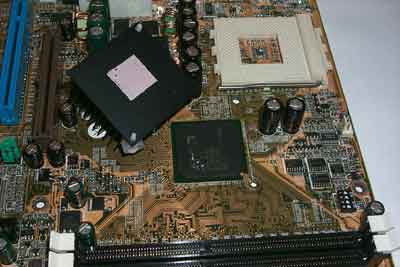
The board has a reasonable number of options for you to tweak the system. 1MHz increments on the FSB, in addition to a wide range of CPU core voltages allows you to push your CPU to the limit. A jumper is used to set the FSB speed range of the board between 100MHz and 133MHz, while the rest of the overclocking settings are found in the BIOS.
The price of the board, on the other hand, is definitely a strong point. For around $110, the CT-7KJD is definitely a good buy for its performance and features among competitors. It might be relatively hard to find the board, as is the case with many Chaintech products, but the price should justify the effort.
DFI AK76-SN
|
DFI AK76-SN |
|
|
CPU
Interface
|
Socket-462
|
|
Chipset
|
AMD
761 North Bridge
VIA 686B South Bridge |
|
Form
Factor
|
ATX
|
|
Bus
Speeds
|
100 - 166 MHz (in 1MHz increments) |
|
Core
Voltages Supported
|
1.475 - 1.850V (in 0.025V increments) |
|
I/O
Voltages Supported
|
N/A
|
|
DIMM
Voltages Supported
|
N/A
|
|
Memory
Slots
|
2
184-pin DDR DIMM Slots
|
|
Expansion
Slots
|
1
AGP Slot |
|
On-board
Audio
|
N/A
|
|
BIOS
|
Award
Modular BIOS 6.00PG
|
One of the major problems we had with the DFI AK76-SN was its memory performance. No matter what brand of memory we used on the system, the system was not able to maintain any stability. We were able to complete all the tests with CAS 2 setting, but all stability tests failed. Changing the memory timing to CAS 2.5 resolved the stability issues, but obviously hurt performance.
Even with the memory set to CAS 2, the performance of the board was not up to par with the rest of the group. Overclocking was OK as long as we used the slowest memory timings. Otherwise the system would become unstable immediately.
The AK76-SN does feature 1MHz increments on the FSB and some CPU core voltage tweakings, although I/O voltage tweaks are missing from. CPU clock multiplier is adjustable through a set of dipswitches on the board.
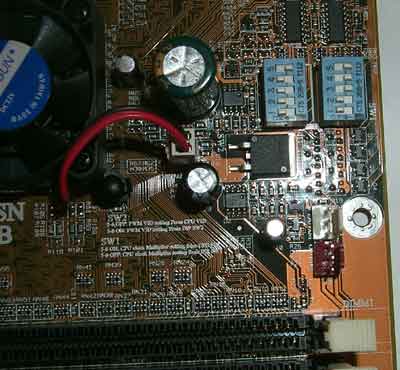
Dipswitches for overclocking on the AK76-SN.
Other than that, the board contains all the standard features you will find on other 760 motherboards. The AK76-SN is also priced quite low at around $110, although the Chaintech board would be a better buy.
EPoX EP-8K7A+
|
EPoX EP-8K7A+ |
|
|
CPU
Interface
|
Socket-462
|
|
Chipset
|
AMD
761 North Bridge
VIA 686B South Bridge |
|
Form
Factor
|
ATX
|
|
Bus
Speeds
|
100 - 166 MHz (in 1MHz increments) |
|
Core
Voltages Supported
|
+0.1 / +0.2 / +0.3 / +0.4V |
|
DIMM
Voltages Supported
|
+0.1
/ +0.2 / +0.3 / +0.4V
|
|
I/O
Voltages Supported
|
N/A
|
|
Memory
Slots
|
2
184-pin DDR DIMM Slots
|
|
Expansion
Slots
|
1
AGP Slot |
|
On-board
Audio
|
VIA VT1611A AC 97 CODEC
|
|
BIOS
|
Award
Modular BIOS 6.00PGN
|
The EPoX EP-8K7A+ came very close to being the best 760 motherboard on the market. In terms of performance and overclocking the EP-8K7A+ is very similar to the ABIT KG7-RAID, falling behind only because of its two DIMM slots .
As such, it's no surprise that before the ABIT KG7-RAID was available, the EP-8K7A+ was was the king of 760 boards. Priced at around $130, $10 lower than the KG7-RAID, the EP-8K7A+ offers lots of overclocking features. Performance and stability of the board is outstanding as well, making the board a very good choice for everyone.
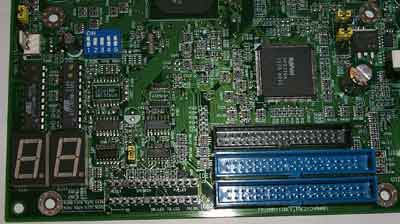
The onboard Highpoint IDE RAID controller.
One shortcoming of the EP-8K7A+ is that multiplier, CPU core voltage, and the DDR voltage are only adjustable through a set of dipswitches on the board, rather than through the BIOS.
EPoX has gone with the Highpoint HPT370A Ultra ATA-100 RAID controller, just like that used on the KG7-RAID. RAID 0, RAID 1, and RAID 0+1 are all supported. The board also features a two digit POST code display for quick diagnosis of any problems you may run into while setting up the system.
If this roundup were done a few months ago, we would have said that the EP-8K7A+ is the best 760 motherboard in the market. However, the presence of the ABIT KG7-RAID has knocked the EP-8K7A+ down a notch. Regardless, the EP-8K7A+ is still a very impressive solution from EPoX, especially when you consider that this was one of the first 760 boards on the market.
FIC AD11
|
FIC AD11 |
|
|
CPU
Interface
|
Socket-462
|
|
Chipset
|
AMD
761 North Bridge
VIA 686B South Bridge |
|
Form
Factor
|
ATX
|
|
Bus
Speeds
|
100 / 103 / 105 / 110 / 113 / 117 / 133 / 138 / 140 / 144 / 150 MHz |
|
Core
Voltages Supported
|
1.475 - 1.825V (in 0.025V increments) |
|
I/O
Voltages Supported
|
N/A
|
|
DIMM
Voltages Supported
|
N/A
|
|
Memory
Slots
|
2
184-pin DDR DIMM Slots
|
|
Expansion
Slots
|
1
AGP Slot |
|
On-board
Audio
|
Advance Logic ALC200 AC'97 CODEC
|
|
BIOS
|
Award
Modular BIOS 6.00PG
|
FIC worked very closely with AMD in developing their DDR platform, allowing them to be one of the first to release a 760 solution, the AD11. Shortly before this roundup, we received an updated revision of the board from FIC, which now has a full HSF unit on the AMD 761 North Bridge. FIC also told us that there are some minor changes on the board for better performance, which seem to be borne out in our test results.
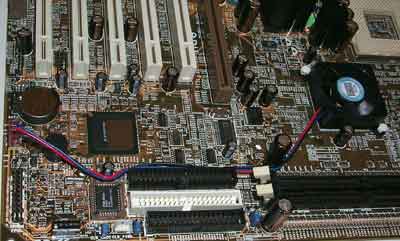
The HSF unit actually uses one of the system fan headers.
The board does not have any settings for I/O voltage, but it does have clock multiplier and CPU core voltage control through two sets of dipswitches. FIC sells the AD11 with a stick of Smart Technology 128MB PC2100 DDR SDRAM as an option. The memory is of quite high quality, and so far the memory has worked great in our lab.
The AD11 is a very nice board for the average user, but overclockers might want to look elsewhere.
Gigabyte GA-7DXR
|
Gigabyte GA-7DXR |
|
|
CPU
Interface
|
Socket-462
|
|
Chipset
|
AMD
761 North Bridge
VIA 686B South Bridge |
|
Form
Factor
|
ATX
|
|
Bus
Speeds
|
95 / 100 - 250 MHz (1MHz increments) |
|
Core
Voltages Supported
|
1.775 / 1.800 / 1.825 / 1.850V |
|
I/O
Voltages Supported
|
2.5 / 2.6 / 2.7V
|
|
DIMM
Voltages Supported
|
1.5 / 1.6 / 1.7V
|
|
Memory
Slots
|
3
184-pin DDR DIMM Slots
|
|
Expansion
Slots
|
1 AGP Pro Slot |
|
On-board
Audio
|
Sigmatel STAC9708T AC 97 CODEC
|
|
BIOS
|
Award
Modular BIOS 6.00PG
|
After several designs, Gigabyte finally settled on the GA-7DXR as their main
product for the 760 market. Gigabyte has invested considerable amount of time
on the board, and the result was quite impressive. In fact, AMD uses Gigabyte
boards in the reference systems they send out with new processor releases, showing
their confidence in Gigabyte.
The first thing we noticed with the 7DXR is that Gigabyte finally departed from
their old AMI BIOS setup and started using the more flexible Award Modular BIOS.
Previously, we had seen that the main reason for Gigabyte's relatively poor
performance lay in their non-optimized memory timings. With the 7DXR and the
Award Modular BIOS, Gigabyte is now up to par with other boards in terms of
performance.
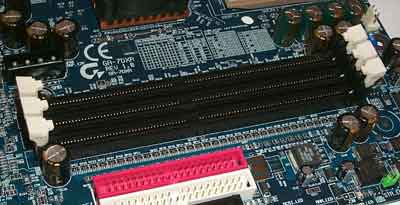
There are three DDR DIMM slots on the GA-7DXR.
You will also find a variety of overclocking options, although most of them are only available via dipswitches on the board, with the FSB being the notable exception. Interestingly enough, our review sample did not include the set of dipswitches used for tweaking the CPU core voltages. In the manual it states that you can adjust the CPU core voltage from 1.5V to 1.85V in 0.025V increments using the dipswitches, whereas our board had the adjustments in the BIOS and a range from 1.775 - 1.850V. Not a big deal, but worth noting.
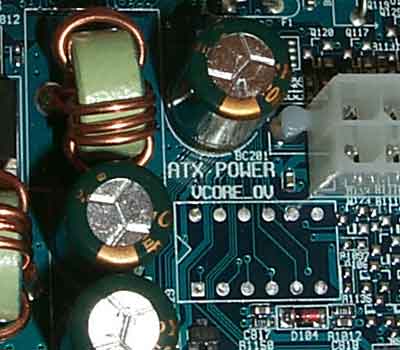
The silkscreen for the dipswitches controlling the CPU core voltage.
The 7DXR features three DIMM slots, rather than the two found on most 760 boards. In fact, it's one of only two boards to offer more than two DIMM slots, the other being the ABIT KG7-RAID. Unfortunately, with all the three DIMM slots populated, we had to back off the CAS latency to 2.5 to maintain sufficient stability.
Like many recent Gigabyte boards, the 7DXR uses the Promise PDC20265R for Ultra ATA 100 RAID, with support for RAID 0 and RAID 1 modes. Also like many boards that use the PDC20265R controller, RAID 0+1 is actually supported on the chip, but not available due to licensing issues with Promise.
Gigabyte of course continues to offer their Dual BIOS setup that should protect you from any failed flashes.
MSI K7 Master-S
|
MSI K7 Master-S |
|
|
CPU
Interface
|
Socket-462
|
|
Chipset
|
AMD
761 North Bridge
VIA 686B South Bridge |
|
Form
Factor
|
ATX
|
|
Bus
Speeds
|
100 / 103 / 105 / 110 / 113 / 117 / 133 / 138 / 140 / 144 /150 MHz |
|
Core
Voltages Supported
|
1.650 - 1.850 (in 0.025V increments) |
|
I/O
Voltages Supported
|
N/A
|
|
DIMM
Voltages Supported
|
N/A
|
|
Memory
Slots
|
2
184-pin DDR DIMM Slots
|
|
Expansion
Slots
|
1 AGP Pro Slot |
|
On-board
Audio
|
VIA VT1611A AC 97 CODEC
|
|
BIOS
|
Award
Modular BIOS 6.00PG
|
The MSI K7 Master-S is the only board in our roundup with an integrated SCSI controller. MSI uses the Adaptec AIC-7899G controller, providing 3 SCSI connectors, two 68-pin and one 50-pin.
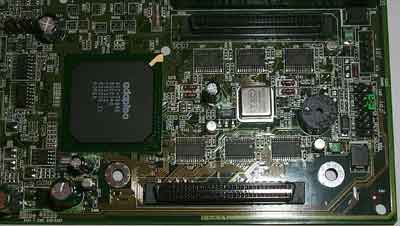
The Adaptec SCSI controller and also two of the three SCSI channels.
History shows that MSI boards usually perform a bit above average, but are usually not at the very top of the charts. They usually sacrifice performance for improved stability. Surprisingly, the performance of the K7 Master-S is extremely good amongst the competition here, but still maintains rock solid stability.
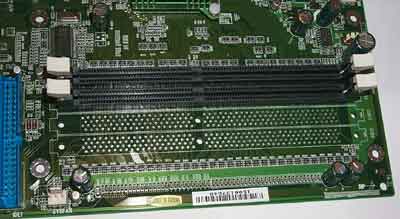
There are actually silkscreens for four DIMM slots, but MSI only includes two.
Unfortunately, the K7 Master-S also suffers from the same multiplier problem we have observed on other MSI boards since the MSI K7T Pro2. Basically, you can't choose any multiplier below the default on your CPU. While this doesn't seem like such a big deal at first, it really poses a problem when trying to overclock to a higher FSB speed, especially if you're starting with a CPU designed for 100MHz operation.
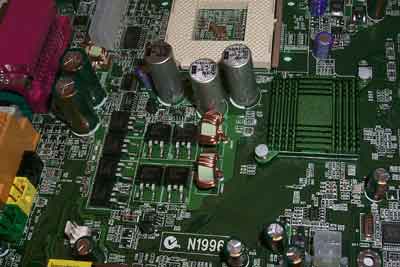
MSI only includes a normal sized heatsink to cool the 761 North Bridge
Overclocking is a relatively weak point on the K7 Master-S as well. You don't have a lot of choices when it comes to FSB speeds, although the top FSB speed of 140MHz that we hit was fairly typical in this group. Of course, MSI is clearly targeting this board more towards servers and workstations with the inclusion of onboard SCSI and overclocking may not be such a big deal there. In fact, MSI does excel in the areas that matter in those markets - performance and stability.
The Performance Test
|
Test Configuration |
|
| Processor(s): |
AMD
Athlon-C (Thunderbird) 1.2GHz Processor (OEM)
|
| RAM: |
1 x 128MB Smart Technology PC2100 DDR SDRAM
1 x 128MB Corsair PC2100 DDR SDRAM 4 x 128MB Hyundai PC2100 DDR SDRAM |
| Hard Drive(s): |
Western
Digital 153BA Ultra ATA 66 7200 RPM
|
| Bus Master Drivers: |
VIA
4-in-1 V4.34V
|
| Video Card(s): |
NVIDIA
GeForce 2 GTS 32MB DDR
|
| Video Drivers: |
NVIDIA
Detonator 21.85
|
| Operation System(s): |
Windows
2000 Professional SP2
|
| Motherboard Revisions: |
ABIT
KG7-RAID Revision 1.0
ASUS A7M266 Revision 1.04 Biostar M7MIA Revision 1.1 Chaintech CT-7KJD Revision 1.0 DFI AK76-SN Revision B EPoX EP-8K7A+ Revision 1.0 FIC AD11 Revision 1.4 Gigabyte GA-7DXR Revision 1.0 MSI 694D Master-S Revision 1.1 |
|
Performance Analysis
All the boards perform within 4% of each other, showing the maturity of the AMD 760 chipset. Worth noting is that the DFI AK76-SN trailed the pack in all our tests. On the other hand, we can see that the ABIT KG7-RAID performs very well, topping all the charts on all our tests.
Feature Comparison Table
|
ABIT
KG7-RAID
|
ASUS
A7M266
|
Biostar
M7MIA
|
Chaintech
CT-7KJD
|
DFI
AK76-SN
|
EPoX
EP-8k7A+
|
FIC
AD11
|
Gigabyte
GA-7DXR
|
MSI
K7 Master-S
|
|
| FSB Speed Range |
100
- 200MHz
|
90
- 180 MHz
|
100
- 150 MHz
|
100
- 165 MHz
|
100
- 166 MHz
|
100
- 166 MHz
|
100
- 140 MHz
|
95
- 250 MHz
|
100
- 140 MHz
|
| 1MHz FSB increments |
Yes
|
Yes
|
No
|
Yes
|
Yes
|
Yes
|
No
|
Yes
|
No
|
| Core Voltage Adjust |
Yes
|
Yes
|
No
|
Yes
|
Yes
|
Yes
|
Yes
|
Yes
|
Yes
|
| I/O Voltage Adjust |
Yes
|
Yes
|
No
|
No
|
No
|
Yes
|
No
|
Yes
|
No
|
| Multiplier Adjust |
Yes
|
No
|
No
|
No
|
Yes
|
Yes
|
Yes
|
Yes
|
Yes
|
| Max Overclocked FSB |
155MHz
|
140MHz
|
140MHz
|
142MHz
|
138MHz
|
149MHz
|
138MHz
|
141MHz
|
140MHz
|
| Stable w/ 2 DIMMs |
Yes
|
Yes
|
Marginally
|
Yes
|
No
|
Yes
|
Yes
|
Yes
|
Yes
|
| Stable w/ 3 DIMMs |
Yes
|
N/A
|
N/A
|
N/A
|
N/A
|
N/A
|
N/A
|
Marginally
|
N/A
|
| Stable w/ 4 DIMMs |
Yes
|
N/A
|
N/A
|
N/A
|
N/A
|
N/A
|
N/A
|
N/A
|
N/A
|
| RAID/SCSI Controller |
Highpoint
HPT370A
|
N/A
|
N/A
|
N/A
|
N/A
|
Highpoint
HPT370A
|
N/A
|
Promise
PDC20265R
|
Adaptec
AIC-7899G
|
| PCI/CNR/AMR/ISA/ACR |
6/0/0/0/0
|
5/0/1/0/0
|
5/0/1/1/0
|
5/1/0/0/1
|
6/0/0/0/0
|
6/0/0/0/0
|
6/1/0/0/0
|
5/0/1/0/0
|
5/1/0/0/0
|
| AGP Pro |
No
|
Yes
|
Yes
|
No
|
No
|
No
|
No
|
Yes
|
Yes
|
| Price |
$140
|
$150
|
$120
|
$110
|
$110
|
$130
|
$105
|
$140
|
$270
|
The Winners and Conclusion
It's been almost a year since the initial release of the AMD 760 chipset, but it's still not too late to consider an AMD 760-based solution. The VIA KT266A and the NVIDIA nForce boards won't be in the market in great quantity for another month, and if you are looking for a motherboard before that time, the 760 should definitely be considered. The SiS 735 is also an option, a faster one in fact, but only the ECS K7S5A is widely available at this point in time.
There is no doubt that the ABIT KG7-RAID is the best AMD 760 board we've seen and thus receives the AnandTech Editor's Choice Gold Award. It has everything you would look for as a hardware enthusiast, especially when it comes to overclocking as we've come to expect from ABIT. The four DIMM slots are unique among AMD 760 boards, a major step ahead of the two slots we usually see.

